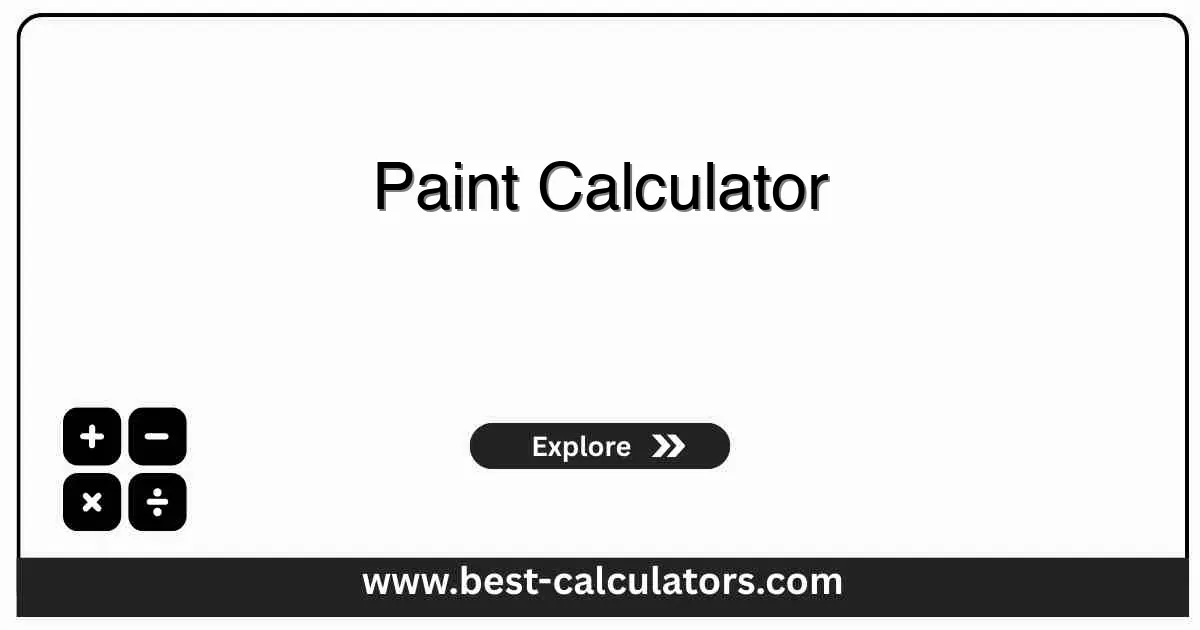Paint Calculator - Estimate Paint Quantity & Costs
Free paint calculator to determine the amount of paint needed for your painting projects including surface area, number of coats, and paint coverage estimates
Paint Calculator
Results
What is a Paint Calculator?
A paint calculator is a free construction tool that helps you estimate the amount of paint needed for your painting projects. It calculates paint requirements based on surface area, number of coats, and paint coverage rates.
This calculator helps with:
- Material estimation - Calculate exact paint quantities to avoid shortages or waste
- Cost planning - Estimate paint costs for budgeting your project
- Project scheduling - Determine project duration based on surface area
- Surface preparation - Plan for primer needs and surface preparation requirements
- DIY projects - Accurately plan home painting projects
Preparing walls for painting? Our Drywall Calculator helps you estimate drywall materials for wall repairs and installations.
Paint Coverage Factors
Several factors influence paint coverage and requirements:
Surface Texture
Smooth surfaces require less paint than rough or textured surfaces.
Paint Type
Latex paints typically cover more area than oil-based paints.
Color Change
Drastic color changes may require additional coats for coverage.
Surface Condition
Bare, stained, or previously unpainted surfaces may need primer.
Types of Paint
Interior Latex
Water-based paint for indoor walls and ceilings. Easy cleanup and quick drying.
Exterior Latex
Weather-resistant paint for outdoor surfaces. Flexible and fade-resistant.
Oil-Based
Durable paint for trim, doors, and high-traffic areas. Longer drying time.
Primer
Base coat for improved adhesion and coverage. Essential for bare surfaces.
How to Use This Paint Calculator
Select Surface Type
Choose the type of surface you're painting (walls, ceiling, etc.)
Enter Surface Area
Input the total area to be painted in square feet
Set Number of Coats
Select how many coats you plan to apply (typically 2)
Choose Paint Type
Select the type of paint you'll use (affects coverage rate)
Select Container Size
Choose your preferred paint container size for purchasing
Get Results
View paint requirements, costs, and project duration
Benefits of Using Paint Calculator
- • Accurate Budgeting: Estimate paint costs before purchasing materials.
- • Material Planning: Determine exact quantities to avoid shortages or waste.
- • Project Scheduling: Plan project duration based on surface area and complexity.
- • DIY Planning: Plan home painting projects with confidence and accuracy.
- • Professional Quotes: Verify contractor estimates and ensure fair pricing.
Factors That Affect Your Paint Requirements
1. Surface Preparation
Proper cleaning, priming, and repair work can significantly affect paint adhesion and coverage.
2. Application Method
Spraying typically uses more paint than rolling, which uses more than brushing.
3. Painter Skill
Experienced painters achieve better coverage with less paint waste than beginners.
4. Environmental Conditions
Temperature and humidity affect paint drying time and application quality.

Frequently Asked Questions (FAQ)
Q: How do I calculate the surface area for painting?
A: Measure the length and height of walls, then multiply length × height for each wall. For ceilings, multiply length × width. For doors and windows, use standard sizes.
Q: How much paint do I need for one coat?
A: One gallon typically covers 350-400 square feet for interior latex paint on smooth surfaces. Coverage varies based on surface texture, porosity, and paint type.
Q: How many coats of paint should I apply?
A: Most projects require 2 coats for even coverage. Heavily stained surfaces or drastic color changes may require 3 coats.
Q: What factors affect paint coverage?
A: Surface texture, porosity, paint type, color, and application method all affect coverage. Rough or porous surfaces require more paint.
Q: Should I account for waste when calculating paint needs?
A: Yes, add 10-15% extra for waste, touch-ups, and potential mistakes. This ensures you have enough paint to complete your project.
Q: How accurate are these paint calculations?
A: These estimates provide a good starting point. Actual requirements may vary based on application technique, surface condition, and painter experience.